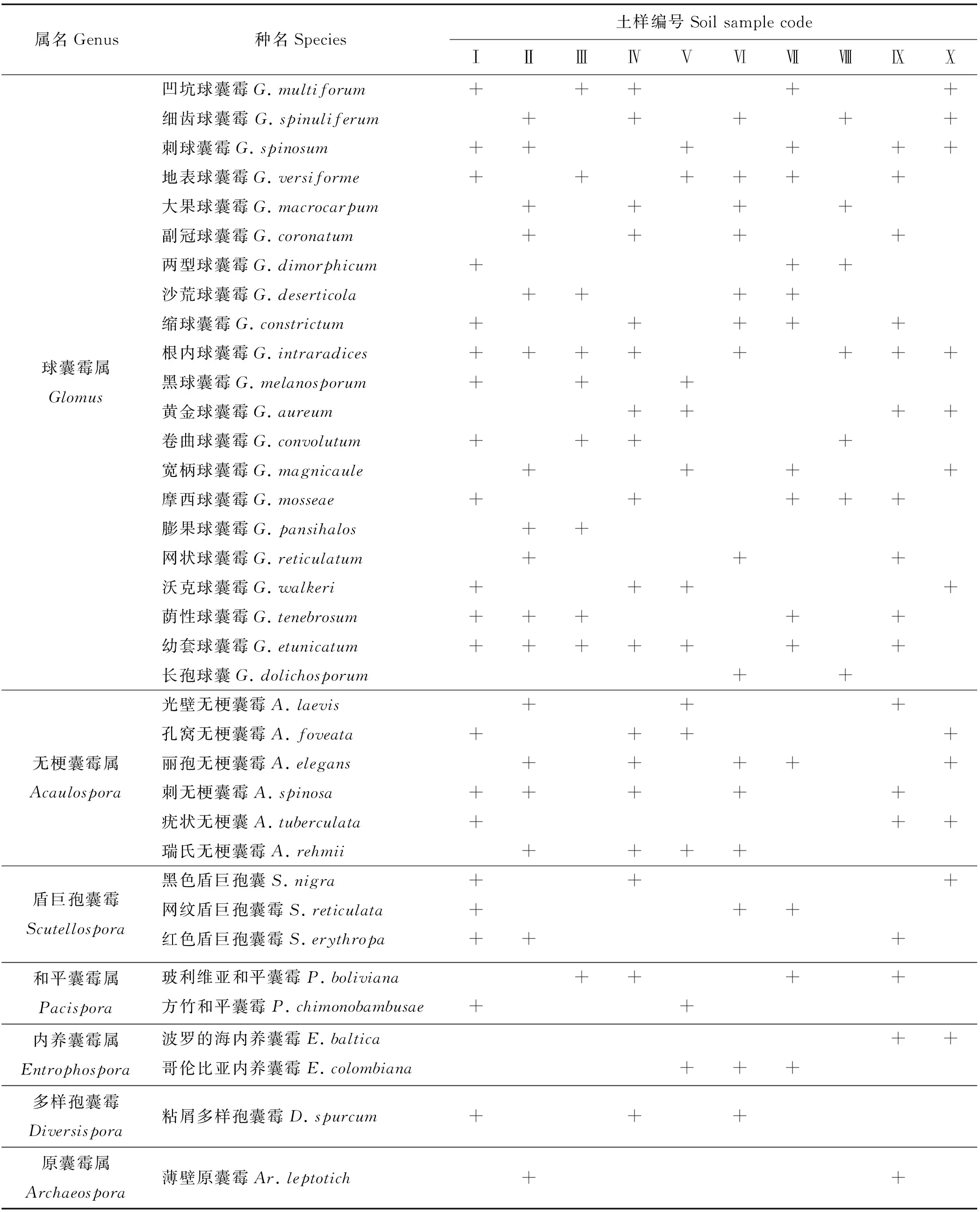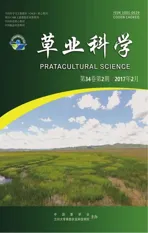松嫩盐碱草地旋覆花根围AM真菌侵染特性及多样性
2017-03-23杨春雪黄寿臣李丽丽
杨春雪,黄寿臣,陈 飞,李丽丽
(东北林业大学园林学院,黑龙江 哈尔滨 150040)
松嫩盐碱草地旋覆花根围AM真菌侵染特性及多样性
杨春雪,黄寿臣,陈 飞,李丽丽
(东北林业大学园林学院,黑龙江 哈尔滨 150040)
为考察松嫩盐碱草地旋覆花(Inulajaponica)根围AM真菌侵染特性及其多样性,本研究对黑龙江省肇东市西南部松嫩盐碱草地旋覆花根系和根际土壤进行分析。结果表明,在不同pH的土壤生境下,旋覆花根系均被AM真菌侵染,在土壤pH为8.76时,侵染率达到100%,泡囊丰度与丛枝丰度达到最大值,分别为75.67%和74.32%;在土壤pH为8.71时,侵染率为85%,泡囊丰度与丛枝丰度最低。通过形态学鉴定共分离出AM真菌8属37种,其中球囊霉属(Glomus)21种,占总种数的56.7%,为优势属,根内球囊霉(G.intraradices)和幼套球囊霉(G.etunicatum)是优势种;无梗囊霉属(Acaulospora)6种,占总种数的16.2%;盾巨孢囊霉属(Scutellospora)3种,占总种数的8.1%;和平囊霉属(Pacispora)、内养囊霉属(Entrophospora)各两种,各占总数的5.4%,巨孢囊霉属(Gigaspora)、多孢囊霉属(Diversispora)、原囊霉属(Archaeospora)各1种,各占总数的2.7%。
松嫩盐碱草地;AM真菌;旋覆花;物种多样性
松嫩盐碱草地地处温带,是我国最大的平原之一,以草甸草原为主体类型[1],自20世纪下半叶以来,由于自然资源的不合理开发与利用加之诸多环境因素的影响,土地盐碱化面积正以2.38%的年增长率不断增加[2],生态环境受到严重破坏。AM真菌(arbusular mycorrhiza fungi)广泛存在于土壤生态系统中,在自然条件下能与90%以上高等植物形成互利共生体系,形成丛枝菌根结构[3]。盐碱胁迫条件下,AM真菌通过分泌多种活性物质活化土壤改善宿主植物根系生长环境,减轻盐分对植物体的毒害,调节植物对水分和养分的吸收,促进宿主根系对磷的吸收最终达到增加植物生长量的效益[4-6]。鉴于AM真菌良好的生态效益,AM真菌在盐碱地的改良与修复中备受关注。
旋覆花(Inulajaponica)是兼具较高耐盐能力和优良园林观赏价值的重要花卉。研究表明,旋覆花可与AM真菌形成良好的共生关系[7],但关于旋覆花根围AM真菌的多样性特征未见报道。本研究拟开展松嫩盐碱草地旋覆花根围AM真菌侵染特性及其多样性的调查研究,筛选鉴定旋覆花根围的优势菌种,旨在进一步开发松嫩盐碱草地的优势AM真菌资源。
1 材料与方法
1.1 研究样地
试验样地位于黑龙江省肇东市,属于松嫩草地的西南部,地处46°13′-47°20′ N,124°18′-125°35′ E,海拔137~138 m,地势平坦,气候类型属温带大陆性半干旱季风气候,冬季持续时间较长且寒冷干燥,夏季时间短属雨热同期,年平均气温4.7 ℃,夏季最高气温为35~40 ℃,冬季最低气温为-33~-25 ℃,年降水量 280~450 mm,主要集中在6月-9 月。松嫩平原盐渍土主要类型包括以碳酸盐为主的盐土、以碳酸钠和碳酸氢钠为主的碱土和盐分含量较低的碱化草甸土3 种土类[8]。
1.2 样品采集
本试验于2014年7月3日在肇东市松嫩盐碱草地采集旋覆花根系及根际土壤。随机选取10株,每株根据“多点平行取样法”和“五点取样法”[9]按照东南西北4个方向随机取样。为保证样品纯净,采集样品为除去表层5 cm厚的土层后攫取深度在10-20 cm的土壤。每份样品均包含根系和根际土壤约1.5 kg,密封保存后标记样地编号及经纬度,于阴凉通风处自然风干。根系通过蒸馏水反复冲洗数次后固定于甲醛-冰醋酸-乙醇固定液(FAA)中[10],根际土壤装袋密封,标记样地编号及经纬度后带回实验室,并将带回土壤于阴凉通风处自然风干后,与根系一并于4 ℃密封保存。
1.3 AM真菌侵染率的测定
采用碱解离-Trypan blue染色法[11]对旋覆花根系进行染色。将旋覆花根系从FAA固定液中取出,剪成1.0 cm左右的长根段并用10% KOH水浴软化后,进行台盼蓝(Trypan blue)染色,在显微镜下观察丛枝、泡囊、菌丝圈、菌丝等结构特征,测定菌根侵染率,每样品20 个重复。其中丛枝丰度(%)、泡囊丰度(%)、侵染强度(%)和侵染率(%)采用参考文献[12]的方法进行统计,利用MYCOCALC软件分析。
1.4 AM真菌孢子的分离鉴定
采用稍加修改的湿筛倾析-蔗糖离心法[13]分离旋覆花根际土壤中AM真菌孢子,将装有筛出物的培养皿置于双管实体解剖镜下统计孢子密度,无菌枪头挑取孢子,观察测定其大小、颜色、孢壁层次和厚度及表面纹饰等特征,初步鉴定孢子种属。挑取单个孢子加PVLG浮载剂压片,利用光学显微镜(OLYMPUS-DSX500)进行观察,并用Melzer’s染色剂对孢子进行染色处理,以观察孢子显色特异性。孢子形态描述参照依据文献[14]、最新发表的AM真菌种属分类资料,同时兼顾其它原始文献及国际丛枝菌根真菌保藏中心(INVAM)国际网站(http://invam.wvu.edu/the-fungi/species-descriptions)上提供的关于模式标本的形态描述及图片,进一步确定孢子种属分类情况[15-17]。
1.5 数据分析
采用SPSS 19.0对AM真菌多样性指标进行方差分析和多重比较(Duncans),用平均值和标准误表示测定结果;采用 Excel 2010对数据进行处理和绘图。
2 结果与分析
2.1 旋覆花根围菌根共生结构特征
旋覆花根系被AM真菌侵染形成典型的疆南星型(Arum-type,A-型)菌根结构(图1),结构特征:菌丝由根外侵入旋覆花根系内(图1-1),菌丝生长于宿主皮层细胞间隙,纵向延伸(图1-2),并侧向分枝进入细胞(图1-5),细胞内有菌丝圈形成(图1-3、1-4),菌丝类型为无隔菌丝(图1-9),通过顶端不断分叉形成典型的花椰菜状丛枝结构(图1-11、图1-12),根内菌丝顶端膨大形成泡囊(图1-6),多为圆形(图1-5)、椭圆形(图1-8)或不规则形(图1-10)。

图1 旋覆花AM真菌菌根显微结构
注:1,菌丝H(hypha)侵入点及根内椭圆形泡囊V(vesicle),×20;2,无隔菌丝H(hypha)侵入根系内呈分枝状,×40;3,根内菌丝圈HC(hyphal coil)及根内孢子S(spore),×20; 4,根内菌丝圈HC(hyphal coil)及椭圆形泡囊V(vesicle)×20; 5,胞间无隔菌丝H(hypha)及圆形泡囊V(vesicle)×20; 6,菌丝H(hypha)二叉状分枝及顶端膨大形成泡囊V(vesicle)×40; 7,根内不规则形泡囊V(vesicle)×20; 8,花椰菜状丛枝A(arbuscular) 及椭圆形泡囊V(vesicle)×40; 9、10,细胞内花椰菜状丛枝A(arbuscular) ×40; 11、12,胞间菌丝H(hypha) 分枝形成丛枝结构A(arbuscular) ×100。
Note: H, hypha; HC, hyphal coil; V, vesicle; S, spore; A, arbuscle. 1, Hypha entry point and intraradical oval vesicles (×20); 2, Non-septate hypha that invaded the root is branching (×40); 3, Hyphal coil and spores in root (×20); 4, Intraradical hyphal coil and oval vesicle (×20); 5, Intercellular hypha and circular vesicle (×20); 6, Branched absorbing structures of hypha and vesicle by swelling (×40); 7, Irregular vesicles in root (×20); 8, arbuscule and oval vesicles (×40); 9, 10, Intercellular cauliflower-like arbuscule (×40); 11, 12, Intercellular hypha branches to arbuscule (×100).
2.2 旋覆花根围AM真菌侵染状况
10 份样地的旋覆花根围土壤pH为8.13~9.30,属碱性至强碱性土(表1)。不同pH土壤生境下,旋覆花根系均被AM真菌侵染,但偏离正态较为明显,因此,在做方差分析之前,将原始数据进行了反正弦转换。结果表明,在土壤pH为最低值8.13和最高值9.30时,侵染率分别为80%和100%,泡囊丰度分别为29.42%和5.68%,丛枝丰度分别为38.89%和43.38%。在土壤pH为8.76时,侵染率达到100%,泡囊丰度与丛枝丰度达到最大值,分别为75.67%和74.32%。在土壤pH为8.71时,侵染率 85%,泡囊丰度与丛枝丰度最低,分别为0.32%和0.87%。
2.3 旋覆花根围AM真菌的多样性
从松嫩盐碱草地旋覆花根围土壤样品中共分离出AM真菌8属37种(图2),其中球囊霉属(Glomus)21种,占总种数的56.7%;无梗囊霉属(Acaulospora)6种,占总种数的16.2%;盾巨孢囊霉属(Scutellospora)3种,占总种数的8.1%;和平囊霉属(Pacispora)、内养囊霉属(Entrophospora)各两种,各占总数的5.4%,巨孢囊霉属(Gigaspora)、多孢囊霉属(Diversispora)、原囊霉属(Archaeospora)各1种,各占总数的2.7%,分别为易误巨孢囊霉(Gigasporadecipiens)、粘屑多孢囊霉(Diversisporaspurcum)和薄壁原囊霉(Archaeosporaleptoticha)。AM真菌在松嫩盐碱草地不仅资源丰富,而且分布广泛。编号分别为Ⅰ、Ⅳ、Ⅹ的土样AM真菌种类较为丰富,分别包含所鉴定37种AM真菌中的27种、18种和17种,各占总鉴定种数的73.0%、48.7%和46.0%(表2)。土样Ⅲ中分离出的AM真菌种类最少,仅为10种,占总鉴定种数37.0%。在所有土样中均有不同程度的分布,其中根内球囊霉(G.intraradices)分布最为广泛,在8个土样Ⅰ、Ⅱ、Ⅲ、Ⅳ、Ⅵ、Ⅷ、Ⅸ、Ⅹ中均得到分离,幼套球囊霉(G.etunicatum)次之,在7个土样中Ⅰ、Ⅱ、Ⅲ、Ⅳ、Ⅴ、Ⅶ、Ⅹ中得到分离,为松嫩盐碱草地旋覆花根围AM真菌常见菌种;方竹和平囊霉(P.chimonobambusae)、薄壁原囊霉(Ar.Leptotich)分别只在土样Ⅰ、Ⅴ和土样Ⅱ、Ⅸ中分离得到,为松嫩盐碱草地旋覆花根围AM真菌偶见菌种。
3 讨论与结论
本研究从黑龙江省肇东市采集旋覆花根系及其根际土壤,属松嫩草地西南部地区,经测定,松嫩盐碱草地旋覆花根围土壤pH为8.13~9.30,属碱性至强碱性土,旋覆花根系被AM真菌侵染形成了典型的疆南星型(Arum-type,A-型)菌根结构。不同pH的土壤生境下,旋覆花根系均被AM真菌侵染。从采集的10 份土样中通过形态学方法分离鉴定出AM真菌8 属37 种,说明松嫩盐碱草地旋覆花根围具有丰富的AM真菌资源,这与对松嫩盐碱草地丛枝菌根真菌多样性特征的研究结果[18-19]相似。球囊霉属真菌是本研究中已鉴定出的37种丛枝菌根真菌的优势属,该结果与其它盐碱地生境中的优势属相同[20]。根内球囊霉在本研究中分布最为广泛,幼套球囊霉次之,为松嫩盐碱草地旋覆花根围AM真菌常见菌种,并且是旋覆花根围的优势菌种。

表1 采样地位置和AM真菌侵染旋覆花根系状况
注:菌根类型为A型,即疆南星型。不同小写字母表示各采样地间差异显著(P<0.05)。
Note: AM type A is Arum-type. Different lower case letters within the same column indicate significant difference between different sampling sites at the 0.05 level.

续图2 本研究分离的8 属37 种AM真菌
本研究结果还显示,在一定范围内,土壤pH对丛枝菌根真菌的分布有一定的影响,随着pH的增加,丛枝菌根真菌侵染率逐渐升高,这可能由于土壤盐碱度直接影响了丛枝菌根真菌产孢能力、菌丝生长、和菌丝侵染能力,并间接地影响了土壤肥力和结构,进而影响AM真菌的产生和种群多样性[21]。有研究发现,AM真菌的多样性和侵染能力对宿主植物有一定的偏好性[22],本研究中,旋覆花根围AM真菌侵染状况和不同AM真菌分布情况反映了旋覆花与不同AM真菌之间的亲和力,在松嫩盐碱草地不同样点间AM真菌和旋覆花的亲和力具有差异性,这说明不同AM真菌与同一植物形成共生体系时存在一定的适应性,这可能与宿主植物根际微生物生物学特性、土壤理化性质如电导率、宿主植物的群落多样性及其化感作用有关[23-25],这一方面还有待于进一步研究。此外,旋覆花根围土壤中的孢子密度和侵染率没有明显的相关性,这与石河子绿洲区苜蓿地丛枝菌根真菌的研究结果[26]一致,可能因为AM真菌的产孢能力对侵染能力没有直接的必然影响,产孢能力强的AM真菌可能侵染能力差[27]。研究结果表明,在松嫩盐碱草地中存在着丰富的可侵染旋覆花根系的AM真菌资源,为筛选和利用耐盐碱AM真菌菌种,充分利用AM真菌资源促进旋覆花在松嫩盐碱草地修复中的应用和在盐碱地区的园林绿化提供了重要理论依据。

表2 松嫩盐碱草地旋覆花根围AM真菌多样性
注:“+”表示在所属研究区域内能够分离得到该AM菌种。
Note: “+” indicates that the AM species has been isolated in the rhizosphere soil in experimental area.
References:
[1] 张毅力.浅谈松嫩草地的类型及其利用.草业科学,1991,8(3):40-42. Zhang Y L.The types and application of Songnen grassland.Pratacultural Science,1991,8(3):40-42.(in Chinese)
[2] 高超,张月学,陈积山,邸桂俐,潘多锋,王建丽,康昕彤,张强,钟鹏.松嫩平原苜蓿和羊草栽培草地土壤氮素动态分析.草业科学,2015,32(4):501-507. Gao C,Zhang Y X,Chen J S,Di G L,Pan D F,Wang J L,Kang X T,Zhang Q,Zhang P.Analysis of soil nitrogen dynamics ofMedicagosativaandLeymuschinensispasture in the Songnen Plain.Pratacultural Science,2015,32(4):501-507.(in Chinese)
[3] 杨海霞,徐萌,刘宁,郭绍霞.丛枝菌根真菌对两种草坪草耐盐性的影响.草业科学,2014,31(7):1261-1268. Yang H X,Xu M,Liu N,Guo S X.Effects of arbuscular mycorrhizal fungi on salinity tolerance of two turfgrass.Pratacultural Science,2014,31(7):1261-1268.(in Chinese)
[4] Bhoopander G,Mukerji K G.Myorrhizal inoculant alvaites salt stress inSesbanaiaegyptiacaandSeshaniagrandifloarunder field conditions:Evidence for reduced sodium and improved magesium uptake.Mycorrhiza,2004,14(5):307-312.
[5] Zhang Y F,Wang P,Yang Y F,Bi Q,Tian S Y,Shi X W.Arbuscular mycorrhizal fungi improve reestablishment ofLeymuschinensisin bare saline-alkaline soil:Implication on vegetation restoration of extremely degraded land.Journal of Arid Environments,2011,75(9):773-778.
[6] 郭艳娥,李芳,李应德,段廷玉.AM真菌促进植物吸收利用磷元素的机制.草业科学,2016,33(12):2379-2390. Guo Y E,Li F,Li Y D,Duan T Y.Progress in the elucidation of the mechanisms of arbuscular mycorrhizal fungi in promotion of phosphorus uptake and utilization by plants.Pratacultural Science,2016,33(12):2379-2390.(in Chinese)
[7] 杨春雪,岳英男.松嫩盐碱草地土壤理化特性与丛枝菌根真菌侵染的相关性.草业科学,2014,31(8):1437-1444. Yang C X,Yue Y N.Relationship between soil properties and the colonization of arbuscular mycorrhizae in Songnen saline-alkaline grassland.Practaculture Science,2014,31(8):1437-1444.(in Chinese)
[8] 张南翼.模拟增温和氮沉降对松嫩草原土壤养分状况的影响.哈尔滨:东北师范大学博士学位论文,2013. Zhang N Y.Effects of warming and nitrogen deposition on soil nutrient status in Songnen Meadow Steppe.PhD Thesis.Harbin:Northeast Normal University,2013.(in Chinese)
[9] 孟繁荣.林木菌根学.哈尔滨:东北林业大学出版社,1996.
[10] Isabel B,Mário C,Luís A,Michael J G.Managing arbuscular mycorrhizal fungi for bioprotection:Mn toxicity.Soil Biology and Biochemistry,2014,68:78-84.
[11] Philips J M,Hayman D S.Improved procedures for clearing roots and staining parasitic and vesicular-arbuscular mycorrhizal fungi for rapid assessment of infection.Transactions of the British Mycological Society,1970,55(1):158-161.
[13] 接伟光.黄檗丛枝菌根真菌鉴定及菌群结构分析.哈尔滨:黑龙江大学硕士学位论文,2008. Jie W G.Identification of mycorrhizal fungi and analysis of the flora structure ofPhellodendronamurense.Master Thesis.Harbin:Heilongjiang University,2008.(in Chinese)
[14] Schenck N C,Péréz Y.Manual for the Identification of VA Mycorrhizal Fungi.2nd edt.INVAM,USA,Gainesville:University of Florida,1989.
[15] 刘润进,焦惠,李岩,李敏,朱新产.丛枝菌根真菌物种多样性研究进展.应用生态学报,2009,20(9):2301-2307. Liu R J,Jiao H,Li Y,Li M,Zhu X C.Research advances in species diversity of arbuscular mycorrhizal fungi.Chinese Journal of Applied Ecology,2009,20(9):2301-2307.(in Chinese)
[16] 王幼珊,张淑彬,张美庆.中国丛枝菌根真菌资源与种质资源.北京:中国农业出版社,2012. Wang Y S,Zhang S B,Zhang M Q.Arbuscular Mycorrhizal Fungi and Germplasm Resources in China.Beijing:China Agriculture Press,2012.(in Chinese)
[17] 杨静.沙柳根围AM真菌多样性及其土壤影响因子研究.保定:河北大学硕士学位论文,2011. Yang J.Biodiversity of arbuscular mycorrhizal fungi and soil factors affection on it in the rhizosphere ofSalixpsammophila.Master Thesis.Baoding:Hebei University,2011.(in Chinese)
[18] 杨春雪,陈飞,岳英男.松嫩盐碱草地26种植物根围丛枝菌根真菌多样性特征.草业科学,2015,32(12):2008-2020. Yang C X,Chen F,Yue Y N.Diversity characteristics of arbuscular mycorrhizal fungi in the rhizosphere of twenty six species of plants in Songnen saline-alkaline grassland.Pratacultural Science,2015,32(12):2008-2020.(in Chinese)
[19] 张义飞.松嫩平原盐碱化草地丛枝菌根真菌资源及其生态作用的研究.长春:东北师范大学博士学位论文,2011. Zhang Y F.Research on the resources and ecological effects of arbuscular mycorrhizl fungi in saline-alkaline grassland of Songnen Plain.PhD Thesis.Changchun:Northeast Normal University,2011.(in Chinese)
[20] 张义飞,毕琪,杨允菲,张忠辉,胡长群,杨雨春,赵珊珊,王相刚.松嫩平原盐碱化羊草群落中真菌物种资源及侵染率研究.草业学报,2015,24(9):80-88. Zhang Y F,Bi Q,Yang Y F,Zhang Z H,Hu C Q,Yang Y C,Zhao S S,Wang X G.Arbuscular mycorrhizal fungi diversity in saline-alkalineLeymuschinensisgrasslands on the Songnen Plain.Acta Prataculturae Sinica,2015,24(9):80-88.(in Chinese)
[21] Bonfim J A,Vasconcellos R L F,Gumiere T.Mescolotti D de L C,Oehl F,Cardoso E J B N.Diversity of arbuscular mycorrhizal fungi in a brazilian atlantic forest toposequence.Microbial Ecology,2016,71(1):164-177.
[22] Aliasgharzadeh N,Saleh N,Rastin H.Alizadeh occurrence of arbuscular mycorrhizal fungi in saline soils of the Tabriz Plain of Iran in relation to some physical and chemical properties of soil.Mycorrhizal,2001,11(3):119-122.
[23] Sun J,Miller J B,Granqvist E,Wiley-Kalil A,Gobbato E,Maillet F,Cottaz S,Samain E,Venkateshwaran M,Fort S,Morris R J,Ane J M,Denarie J,Oldroyd G E.Oldroyda G E.Activation of symbiosis signaling by arbuscular mycorrhizal fungi in legumes and rice.The Plant Cell,2015,27(3):823-838.
[24] Higo M,Isobe K,Kondo T,Yamaguchi M Y.Temporal variation of the molecular diversity of arbuscular mycorrhizal communities in three different winter cover crop rotational systems.Biology and Fertility of Soils,2015,51(1):21-32.
[25] 李桂真,陈志超,李新川,盛建东,黄长福,金俊香.新疆盐生植物芦苇根围AM真菌的空间分布特征.草业科学,2016,33(7):1267-1274. Li G Z,Chen Z C,Li X C,Sheng J D,Huang C F,Jin J X.Spatial distribution characteristics of arbuscular mycorrhizal fungi in the rhizosphere of halophytesPhragmitesaustralisin Xinjiang.Pratacultural Science,2016,33(7):1267-1274.(in Chinese)
[26] 任爱天,鲁为华,杨洁晶,马春晖.石河子绿洲区苜蓿地丛枝菌根真菌的多样性及与土壤因子的关系.草业科学,2014,31(9):1666-1672. Ren A T,Lu W H,Yang J J,Ma C H.Arbuscular mycorrhizal fungi diversity and its relationship with soil environmental factors in oasis alfaifa planting of Shihezi.Practaculture Science,2014,31(9):1666-1672.(in Chinese)
[27] Marcel G A,van Der H.The unseen majority:Soil microbes as drivers of plant diversity and productivity in terrestrial ecosystems.Ecology Letters,2008,11(3):296-310.
(责任编辑 苟燕妮)
Infection characteristics and diversity of arbuscular mycorrhizal fungi in the rhizosphere ofInulajaponicain Songnen saline-alkaline grassland
Yang Chun-xue, Huang Shou-chen, Chen Fei, Li Li-li
(College of Landscape Architecture, Northeast Forestry University, Harbin 150040, China)
In order to inspect the infection characteristic and diversity of arbuscular mycorrhizal (AM) fungi in the rhizosphere ofInulajaponicain the Songnen saline-alkaline grassland in Zhaodong, Heilongjiang Province, roots and rhizosphere soil ofI.japonicawere collected from the southwest part of the grassland in July 2015. All roots, despite different soil pH levels, were infected by AM fungi. The infection rate reached 100% at pH 8.76, when the abundance of arbuscules and vesicles also reached maximums of 75.67% and 74.32% respectively. When the soil pH was 8.71, the infection rate was 85%, and the abundance of arbuscules and vesicles were at their lowest levels. 37 AM fungal species from 8 genera were isolated by mor-phological analysis. The 21 species belonging toGlomusaccounted for 56.7% of all species, makingGlomusthe dominant genus;G.intraradicesandG.etunicatumwere the most common species. There were 6 species ofAcaulospora(16.2% of all species), 3 species ofScutellospora(8.1% of all species), 2 species of eachPacisporaandEntrophospora(each 5.4% of all species), and 1 species of eachGigaspora,Pacispora, andEntrophospora(each 2.7% of all species).
Songnen saline-alkaline grassland; AM fungi;Inulajaponica; species diversity
Yang chun-xue E-mail:senxiu99@163.com
10.11829/j.issn.1001-0629.2016-0175
S812;Q948.15
A
1001-0629(2017)2-0231-09*
2016-04-04接受日期:2016-09-07
国家自然科学基金“星星草-丛枝菌根共生体应答盐碱逆境的生理机制解析(31601986)”;中央高校基本科研业务费专项资金“松嫩盐碱草地星星草根围AM真菌多样性与功能研究(2572015CA22)”;东北油田盐碱植被恢复与重建教育部重点实验室开放基金“松嫩盐碱草地马蔺根围AM真菌多样性研究 (SAVER1608)”
杨春雪(1977-),女,黑龙江伊春人,副教授,博士,主要从事菌根生理生态方面的研究。E-mail:senxiu99@163.com
杨春雪,黄寿臣,陈飞,李丽丽.松嫩盐碱草地旋覆花根围AM真菌侵染特性及多样性.草业科学,2017,34(2):231-239.
Yang C X,Huang S C,Chen F,Li L L.Infection characteristics and diversity of arbuscular mycorrhizal fungi in the rhizosphere ofInulajaponicain Songnen saline-alkaline grassland.Pratacultural Science,2017,34(2):231-239.
